This is a list of flags used in the Kingdom of the Netherlands. For more information about the national flag, visit the article Flag of the Netherlands.
National flag
| Flag | Date | Use | Description |
|---|---|---|---|
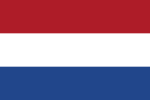 |
1813–1815 | Flag of the Sovereign Principality of the United Netherlands | A horizontal tricolour of red, white and blue. |
| 1815–1839 | Flag of the United Kingdom of the Netherlands | ||
| 1839–present | Flag of the Kingdom of the Netherlands. | ||
 |
?–present | Hanging pennon | Hanging variant of the national flag |
 |
?–present | Orange pennon | Orange is the colour of the Royal Family |
Constituent countries
| Flag | Date | Use | Description |
|---|---|---|---|
 |
1839–present | Flag of the Netherlands | A horizontal tricolour of red, white and blue. |
 |
1976–present | Flag of Aruba | A medium blue field with a white fimbriated (bordered) red four-pointed star in its upper hoist corner and two narrow horizontal yellow stripes in its lower half. |
 |
1984–present | Flag of Curaçao | A blue field with a horizontal yellow stripe slightly below the midline and two white five-pointed stars in the canton. |
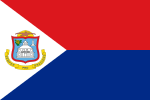 |
1985–present | Flag of Sint Maarten | A white triangle situated at the hoist charged with the constituent country's coat of arms, along with two horizontal bands of red and blue. |
Provinces
| Flag | Date | Use | Description |
|---|---|---|---|
 |
1947–present | Flag of Drenthe | A white flag with two horizontal red stripes, between the two stripes there is a black tower and six red stars.[1] |
 |
1986–present | Flag of Flevoland | The flag is tierced in fess azure, or and vert, a fleur-de-lis argent is placed in the canton.[2] |
 |
1957–present | Flag of Friesland | A flag consists of four blue and three white diagonal stripes; the white stripes filling with a total of seven red pompeblêden. |
 |
1953–present | Flag of Gelderland | Horizontal tricolour flag in blue, yellow (gold) and black |
 |
1950–present | Flag of Groningen | A flag with a green cross fimbriated in white, and red in the first and fourth quarter, blue in the second and third quarter. |
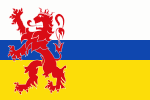 |
1953–present | Flag of Limburg | A flag with tricolour band in white, blue and yellow (proportion 2:1:2), and a red lion rampant towards hoist side. |
 |
1959–present | Flag of North Brabant | A flag consists of a chequy pattern alternatively in red and white |
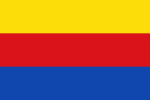 |
1958–present | Flag of North Holland | Horizontal tricolour flag in yellow, red and blue |
 |
1948–present | Flag of Overijssel | A yellow flag with two red bands in top and bottom, and a blue wavy band in the middle. |
 |
1985–present | Flag of South Holland | A yellow flag with a red lion rampant towards hoist side |
 |
1952–present | Flag of Utrecht | Horizontal bicolour flag in white and red, and a red square filling with white cross in the canton. |
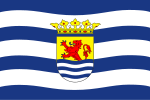 |
1949–present | Flag of Zeeland | A flag with wavy bands in blue and white, and the coat of arms of Zeeland in the centre. |
Public bodies
| Flag | Date | Use | Description |
|---|---|---|---|
 |
1981–present | Flag of Bonaire | A large blue triangle and a smaller yellow triangle, separated by a white strip containing a black compass and a red six-pointed star. |
 |
1985–present | Flag of Saba | Two equal red triangles at the top and two equal blue triangles at the bottom, with a white diamond with yellow star in the middle. |
 |
2004–present | Flag of Sint Eustatius | Four colours blue, red, white, gold and green, and divided in four five-sided blue polygons, each fimbriated red. In its centre is a diamond-form white field; in the diamond is the silhouette of the island in green. In the centre in the top of the diamond is a five-pointed golden/yellow star. |
Municipalities
| Flag | Date | Use | Description |
|---|---|---|---|
 |
1959–present | Flag of Amersfoort, a city in the province of Utrecht, and is situated at the eastern edge of the Randstad. | Three horizontal stripes in red and white with two red blocks are placed below and above and a Saint George's cross on the hoist side[3] |
 |
1975–present | Flag of the national capital, Amsterdam | Coat of arms of Amsterdam presented horizontally on field |
 |
?–present | Flag of Arnhem, the capital city of the largest province of Gelderland | A bi-colour field with white in the top and blue in the bottom, and a double-headed eagle towards hoist |
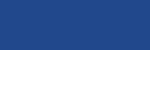 |
1959–present | Flag of Assen, the capital of the province of Drenthe | A bi-colour flag with blue in the top and white in the bottom |
 |
1996–present | Flag of Delft, home of the Delft University of Technology and Johannes Vermeer | Coat of arms of Delft presented horizontally on field |
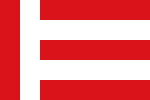 |
1927–present | Flag of Eindhoven, the largest city of the province of North Brabant | A flag with two vertical stripes in red and white in the hoist side, and five horizontal strips alternatively in red and white |
 |
2023–present | Flag of Enschede, the largest city of the Twente region and the province of Overijssel | A white field with a red stripe with a battle fence |
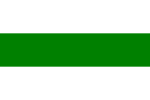 |
1879–present | Flag of the city of Groningen, the capital of the province of Groningen | A white field with a green stripe |
 |
?–present | Flag of Haarlem, the capital of the province of North Holland | A red field with the coat of arms of Haarlem towards hoist |
 |
1966–present | Flag of Heerlen, a city in the south of the province of Limburg | A blue field with a golden eagle in the middle |
 |
1999–present | Flag of 's-Hertogenbosch, the capital of the province of North Brabant | A flag with five stripes alternatively in red and white, and a black square with a yellow tree in the canton |
 |
1958–present | Flag of Hilversum, the largest city of the Gooi area | Coat of arms of Hilversum in banner form |
 |
2019–present[4] | Flag of Leeuwarden, the capital of the province of Friesland | A blue flag with a yellow lion rampant in the middle and two vertical stripes alternatively in red and white in the hoist side |
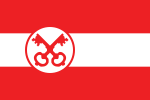 |
1949–present | Flag of Leiden, a city in South Holland with the oldest Dutch university Leiden University and birthplace of Rembrandt | A red field with a white stripe in the middle, and a white disc towards hoist with red border and two crossed red keys |
 |
1981–present | Flag of Lelystad, the capital of the province of Flevoland | A yellow field with a blue hexagon filling with a white fleur-de-lis towards hoist and surrounding by four Ls |
 |
1545–1549, 1647–? (1938), 1994–present | Flag of Maastricht, the capital of the province of Limburg | A white five-pointed star in the red field, towards hoist |
 |
1974–present | Flag of Middelburg, the capital of the province of Zeeland | Coat of arms of Middelburg in banner form |
 |
1949–present | Flag of Rotterdam, the second city of The Netherlands | A white stripe in the green field |
 |
1984–present | Flag of Scheveningen, a seaside resort and a district of The Hague | In azure with three right swimming herrings of silver, each herring with a three-leaved yellow crown, floating above the head. |
 |
1456–present | Flag of Sneek, the second city of the province of Friesland | A flag with hoist half in black and fly half in yellow |
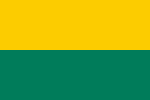 |
1949–present | Flag of The Hague, the capital of the province of South Holland | A flag with yellow at the top and green at the bottom |
 |
1990–present | Flag of the city of Utrecht, the capital of the province of Utrecht | A bi-colour flag in white and red field and partly per bend |
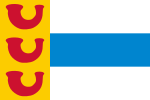 |
1980–present | Flag of Weert, a town in the centre of the province of Limburg | A white field with a blue horizontal stripe in the middle, and a yellow vertical stripe in the hoist side surmounted with three red horns |
 |
1962–present | Flag of Zwolle, the capital of the province of Overijssel | A blue field with a white cross |
Regions
| Flag | Adopted | Use | Description |
|---|---|---|---|
 |
2018 | Flag of the Achterhoek | The flag has been in use in its current form since 2018 and was created as a result of a design competition. In the process, this design was chosen from 475 entries. The flag is now well known in the Achterhoek and can be seen flying here and there. The flag shows a creamy white diagonally curved cross surrounded by a dark green border. This cross depicts the winding roads of the Achterhoek and the rows of trees along them. Because of the cross, the flag is divided into four and consists of two light green areas and two dark green areas in the background. Light green represents the meadows and dark green represents the Achterhoek forests. The flag design is inspired by the Achterhoek coulisse landscape. This is a semi-open landscape that has the character of a stage with wings due to the planting and buildings. Scenes are the parts of the stage where players come from and return.[5][6] |
 |
2022 | Flag of the Batavia | The flag has been in use in its current form since 2022 and was created as a result of a design competition. In the process, this design was chosen from some dozens of entries with a 23% victory of the votes. The flag serves as a symbol for the region and as a means of representing its identity. The flag has a green background with three narrow vertical stripes in red and blue on the mast side. These stripes are derived from the coat of arms of the noble family de Cocq van Haeften. They played an important role in the region during the Middle Ages. This coat of arms was also often used as inspiration for arms of various (disbanded) villages and towns in the Batavia. The stripes symbolise all these places. The green background refers to the region's landscape: lots of woods, heathland and other nature. Placed on top are two wavy horizontal stripes referring to the rivers Waal and Rhine. Central to the flag are three silhouettes of apples. These refer to the three Batavia regions that make up the area: the Tielerwaard, Lower Batavia and Upper Batavia.[7] |
 |
20 December 1961 | Flag of Beemster | The flag has been adopted on 20 December 1961 in its current form, and at that time served as the municipal flag of the former Beemster municipality. Nowadays, Beemster falls under the municipality of Purmerend, and it became the regional flag of the same name. This colourful flag, which closely resembles the flag of Terschelling, is made up of four stripes in the colours red, green, yellow and blue. These colours are based on the municipal coat of arms. The red colour symbolises the sun, the green colour the land, the yellow colour the grain and the blue colour the water. All these symbols are included in the municipal coat of arms except the grain.[8] |
 |
29 June 1955 | Flag of het Bildt | The flag has been adopted on 29 June 1955 in its current form, and at that time served as the municipal flag of the former het Bildt municipality. Nowadays, het Bildt falls under the municipality of Waadhoeke, and on 23 January 2020, the municipal council decided that the flag will be given a second life as a regional flag. The flag has a colourful design and consists in the background of three horizontal stripes in green, white and blue. The flag's tripartite division refers to the original division of het Bildt into three parishes. Green, white and blue are taken from the corresponding municipal coat of arms. White in the flag refers to the former Middelzee between Aldlân (blue) and Nijlân. The mast side of the flag shows a triangle, which is also divided into three. This triangle indicates the geographical shape of the reclaimed polders. Red and yellow refer to the county of Holland. This is because the Dutch played a major role in the embankment.[9][10][11][12] |
 |
12th century | Flag of Brabant | The flag is black and features the well-known Brabantian or Flemish lion. This is a standing yellow (or golden) lion with red tongue and nails. This lion has also traditionally featured on the coat of arms of the province of North Brabant. It seems that the first Duke of Brabant, Godfrey I, carried this lion as a heraldic symbol. At the time, it was depicted in various banners as early as 1106. A century later, Henry I started using this same lion in his coat of arms. The flag is also formed the banner of the former Duchy of Brabant and the former Brabant in Belgium. The flag is believed to be centuries old and in use at least before the year 1815. The flag was also conducted in square form. |
 |
23 February 2016 | Flag of Drechtsteden | In its current form, the flag has been in concept since 2016 and devised by a Dordrecht visual artist. The design was only presented but never officially put into use. The flag basically consists of three horizontal stripes in red and white. This makes the flag quite similar to the flag of Dordrecht. This was also an immediate criticism of the flag. It was said to be too similar to the flag of Dordrecht and lacked characteristics of other place flags from the region. The red stripes feature a diagonal white stripe. White can be interpreted in the flag as iconic rivers that cross the region. Red can then represent buildings around these rivers.[13][14] |
 |
Unknown | Flag of Eastergoa | The flag design consists of five horizontal stripes in the colours red and white. It is not known exactly since when the Eastergoa flag has been in use. However, it is known that the flag is based on its coat of arms. Where exactly these colours come from is not clear. |
 |
23 September 2006 | Flag of Frisia | The flag is yellow and features a white Nordic cross with a blue border. This divides the flag into quarters, so to speak. Each quarter features a red seeblatt (pompeblêd), a well-known heart-shaped Frisian symbol representing the leaf of a water lily. The design of the Interfrisian flag was the work of the activist group Groep fan Auwerk. They promote a stronger Frisian identity and are in favour of an independent Frisian state. The thin cloth is not very well known, unlike the provincial flag of Friesland.[15] |
 |
15 July 1963 | Flag of Gaasterland | The flag can be seen as the regional flag of the Frisian region Gaasterland (or Gaasterlân). It has been adopted on 15 July 1963 in its current form, and at that time served as the municipal flag of the former Gaasterland municipality. Nowadays, Gaasterland falls under the municipality of De Fryske Marren, and it became the regional flag of the same name. The flag consists of three horizontal stripes in blue, yellow and green. The middle yellow stripe is thicker and contains a leaping red hare. Together with the flag colours, this hare is taken from the municipal coat of arms. In it, it jumps over a green meadow with corn behind it and a blue sky. The hare's provenance is unfortunately unknown.[16] |
 |
13 February 2020 | Flag of the Land of Meuse and Waal | The flag has been in use in its current form since 2020 and was created following a design competition. In this, this design was chosen from three designs, with 752 votes. The flag shows three horizontal stripes in white, blue and green. At the centre of the design is a yellow coat of arms in the middle in which two wavy rivers forming the letters M and W. The two designs that fell off also contained the letters of Meuse and Waal but were a lot tighter in design. The flag was designed by Wim Hendriks.[17] |
 |
2021 | Flag of the Liemers | The flag has been in use in its current form since 2021 and was created following a design competition. In this, this design was chosen from some 100 entries, with a 37% victory. The flag looks modern, is dark red and shows a red twisted Y-shape with white outline. This Y-shape is based on the region's borders and its connection to the IJssel and Rhine rivers. It is, as it were, a simplified form of this geographical entity. The red colour has several meanings. For instance, it stands for the indication of 'standing out' which is often attributed to this bright colour. It also stands for enthusiasm, strength, love, passion and warmth. The flag is slightly similar to the regional flag of Achterhoek. The white lines and curved shape are reminiscent of it.[18] |
 |
14 October 1987 | Flag of Northern Limburg | The flag basically consists of two white stripes and a narrower blue stripe. The blue stripe is split by a green shape that resembles both the uppercase letter G and the lowercase letter E. Exactly how the flag was created is unclear. |
 |
Before 1900 | Flag of the Ommelanden | The flag is very similar to the flag of the province of Friesland but shows red heart shapes instead of seeblatts (or pompeblêden). Both flags are regularly mixed up and are so similar because of the common past of Ommelanden and Friesland. However, the flag of Ommelanden is older; its design is directly derived from the corresponding coat of arms, which dates back to the 16th century. The background of the flag consists of seven diagonal stripes in white and blue. Eleven red hearts are distributed across the white stripes. These hearts are also called 'water rose plums'. What these refer to is not exactly known. The flag is believed to have been used before 1900.[19][20] |
 |
25 June 1991 | Flag of Rheiderland | The flag can be seen as the regional flag of the Groningen region of Rheiderland. It has been adopted on 25 June 1991 in its current form, and at that time served as the municipal flag of the former municipality of Rheiderland. Nowadays, Rheiderland falls under the municipality of Oldambt and it became the regional flag of the same name. The flag consists of a yellow and blue field separated by a embattled line. The flag colours are taken from the corresponding coat of arms. The battlements indicate the presence of several fortresses (including Bad Nieuweschans) in historic Rheiderland. The blue colour predominates, as this is also the case in the municipal coat of arms.[21] |
 |
September 2021 | Flag of Salland | The flag was designed by Mr Dijk after holding a design competition. The winning design was officially adopted in September 2021. Previously, Salland used a different flag. The flag has a modern design and consists of five colours: light blue, green, yellow, dark blue and white. The light blue stripe at the top represents the sky, while the yellow and green at the bottom symbolise the fields and meadows. The green triangular area at the top right represents the Sallandse Heuvelrug National Park. The colour areas are separated from each other by white lines. The horizontal white line represents the horizon. To the right of the flag is a vertical wavy blue stripe representing both the letter S of Salland and the rivers that cross Salland.[22] |
 |
Unknown | Flag of Sânwâlden | The flag consists of fifteen equal blocks in white and green. Together they form a chequered pattern. Officially, the flag is slightly wider, and the blocks have a square shape. The green blocks are a reference to the seven trees shown on the coat of arms of Sânwâlden. White has been used as the background colour of the coat of arms in this regard. |
 |
30 May 2000 | Flag of Schermer | The flag can be seen as the regional flag of the North Holland region of Schermer. It has been adopted on 30 May 2000 in its current form, and at the time served as the municipal flag of the former municipality of Schermer. Today, Schermer falls under the municipality of Alkmaar and it became the regional flag of the same name. The flag basically consists of a blue and green area separated by a yellow chevron (arrow-shaped element). The flag colours come from the flag of the former water board De Schermeer. The sails and the pike are taken from the municipal coat of arms. The sales represent the polder mill depicted on it. This mill symbolises the village of Schermerhorn, which still has several of these mills. The pike was eventually derived from the coat of arms of Zuid- en Noord-Schermer. This is a former municipality which carried two pikes on its coat of arms.[23] |
 |
2009 | Flag of Stellingwarfs | The design was specially conceived to celebrate the 700th anniversary of this area. The flag is white with a horizontal red stripe at the bottom and top. At the bottom, however, the stripe is interrupted with the text 'Stellingwarf' in italics. In the centre of the flag are two silhouettes of a griffin. These mythical creatures represent the two municipalities of Ooststellingwerf and Weststellingwerf and are also derived from respective municipal flags. Ooststellingwerf and Weststellingwerf are the municipalities whereby far the most Stellingwarfs live. Red and white are the traditional colours there.[24] |
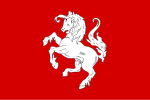 |
1981 | Flag of Twente | The flag is red and shows a white prancing horse in the centre. This represents the so-called Saxon Steed (or Twentse Ros). Most likely, this horse originated from the Saxons, who considered it a noble animal. The Saxons owned Twente for a long time as part of their Saxon Empire. The story also goes that the horse represents the divine horse Sleipnir. This eight-legged hoofed animal originates from Norse mythology and was considered the fastest horse in existence. Today, the symbol of Twente can be found in many logos and other expressions.[25] |
 |
2012 | Flag of the Veluwe | The flag is yellow and never officially recognised. A blue horizontal stripe is included at the top and bottom. At the centre of the flag is a black silhouette of a leaping (red) deer. This is a common part in the Veluwe forests. The flag elements are all taken from the flags of some municipalities located (partly) in the Veluwe. Yellow, blue and black also form the colours of the provincial flag of Gelderland. |
 |
2008 | Flag of West Frisia | The flag was introduced by the mayor of Hoorn. The flag is blue and shows in the foreground two yellow (golden) going lions (or leopards) surrounded by five rectangular squares (peas). Previously, it was not five but seven peas, referring to the seven sea countries. The lions are ancient armorial animals and, in the case of West Friesland, date from the 14th century. The flag design is derived from the historical flag and arms of West Friesland, which are several centuries old. |
 |
Unknown | Flag of Westergoa | The flag design consists of a blue background split by a white diagonal stripe. It is not known exactly when the flag has been in use. However, it is known that the flag is based on its coat of arms. Where exactly these colours come from is not clear. |
 |
3 March 1987 | Flag of Westland | The flag consists of five zigzag stripes in white and green. At the top and bottom of the flag, these zigzag bands merge into three green triangles. The zigzag stripes represent the (plant) greenhouses that are common in Westland. Here, green refers to the cultivated plants and white to the greenhouses themselves. The flag of the municipality of Westland also shows some cartel stripes with a similar meaning. |
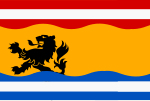 |
5 January 2009 | Flag of Zeelandic Flanders | The flag shows a yellow wavy stripe in the middle, which divides the flag in two. Together with the black climbing lion placed inside it, it refers to the flags of Flanders and Hulst. The lion was slightly modernised for the flag design so that it looks more like a young, dynamic lion. At the top, the flag shows three horizontal stripes in red and white. These are taken from the municipal flag of Sluis. At the bottom are three horizontal stripes in blue and white. These are taken from the municipal flag of Terneuzen. They refer to the North Sea, the Zwin and the Western Scheldt.[26] |
Royal family
Royal standard
| Flag | Date | Use | Description |
|---|---|---|---|
 | 2013–present | Royal flag (Dutch: koninklijke vlag), or the royal standard, of the kingdom's monarch | A square orange flag, divided in four quarters by a nassau-blue cross with the small coat of arms of the Kingdom, surmounted by a royal crown and surrounded by the insignia of the Grand Cross of the Order of William. Each quarter shows a bugle-horn, which originates in arms of the Principality of Orange. |
Other members of the royal family
| Flag | Date | Use | Description |
|---|---|---|---|
 | 1985–present | Princes of the Netherlands (Sons of Beatrix) Constantijn and formerly Johan-Friso |
As princes of the Netherlands use a 5:6 rectangular flag with the Royal standard colours and their parental arms (a white tower) in the lower hoist as difference. |
 | 1988–present | Princes of the Netherlands (Sons of Margriet) Maurits, Bernhard, Pieter-Christiaan and Floris |
As princes of the Netherlands use a 5:6 rectangular flag with the Royal standard colours and their parental arms (a white six pointed star) in the lower hoist as difference. |
 | 1960–present | Princesses of the Netherlands (Daughters of Juliana) Beatrix, Irene, Margriet and Christina |
As princesses of the Netherlands use a swallow tailed flag, with the Royal standard colours and their parental arms (a heraldic rose) in the lower hoist as difference. |
 | 2021–present | Princesses of the Netherlands (Daughters of Willem-Alexander) Catharina-Amalia, Alexia and Ariane |
As princesses of the Netherlands use a swallow tailed flag, with the Royal standard colours and their maternal arms (the tower of Zorreguieta) in the lower hoist as difference. |
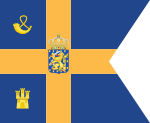 | 2002–present | Máxima of Orange-Nassau | As queen, Máxima uses a swallow tailed standard, with the colours of her husband's flag changed and her parental arms (a yellow tower) in the lower hoist. |
 | 2003–present | Laurentien of Orange-Nassau | As princess, Laurentien uses a swallow-tailed standard, with the colours of her husband's flag counterchanged and her parental arms (a yellow heraldic lozenge) in the lower hoist. |
Governmental flags
| Flag | Date | Use | Description |
|---|---|---|---|
 | 2011-present | Flag of the government of the Netherlands | Light blue field with a white one-third width post next to the post and containing at the top the emblem of the Dutch Government and its agencies. |
 | 1986-present | Flag of the governor of Aruba | A white flag with the flag of the Netherlands striped across both the top and the bottom, and a badge of the flag of Aruba in the centre. |
 | 2010-present | Flag of the governor of Curaçao | A white flag with the flag of the Netherlands striped across both the top and the bottom, and a badge of the flag of Curaçao in the centre. |
 | 2010-present | Flag of the governor of Sint Maarten | A white flag with the flag of the Netherlands striped across both the top and the bottom, and a badge of Sint Maarten in the centre. |
Military and naval flags
| Flag | Date | Use | Description |
|---|---|---|---|
 | 1974-present | Flag of a minister, except the Minister of Defence | Seven horizontal bands in the colour combination red-white-blue-white-red-white-blue in the ratio 1:1:1:6:1:1:1 with a crowned lion with a sword and a bundle of arrows in the middle. |
 | 2023-present | Flag of the Minister of Defence | Seven horizontal bands in the colour combination red-white-blue-white-red-white-blue in the ratio 1:1:1:6:1:1:1 with two crossed yellow swords topped by a yellow crown. |
 | 1957–present | Flag of the Secretary of Defence | Seven equally high horizontal bands in the colour combination red-white-blue-white-red-white-blue. |
 | 2005–present | Flag of the Chief of Defence of the Netherlands Armed Forces | Seven equally high horizontal bands in the colour combination red-white-blue-white-red-white-blue. In the middle, a green circle with three swords representing the armed forces, except for the Royal Marechaussee. |
 | 1982–present | Flag of the Inspector General of the Netherlands Armed Forces | Seven equally high horizontal bands in the colour combination red-white-blue-white-red-white-blue. In the middle, the coat of arms of the Inspector General of the Armed Forces. |
 | 1937–present | Flag of the Royal Netherlands Navy | A horizontal tricolour of red, white and blue. |
 | 2011–present | Governmental flag of the Royal Netherlands Navy | Blue field with a white one-third width post next to the post and containing at the top the emblem of the Royal Netherlands Navy in orange. |
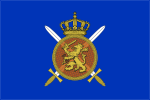 | ?–present | Flag of the Royal Netherlands Army | Blue flag, loaded in the middle with the coat of arms of the Royal Netherlands Army. |
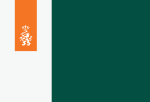 | 2011–present | Governmental flag of the Royal Netherlands Army | Green field with a white one-third width post next to the post and containing at the top the emblem of the Royal Netherlands Army in orange. |
 | 1948–present | Flag of the Royal Netherlands Air Force | Blue flag, divided in three by an orange point coming from the breech side. Originally loaded with the decorations of the Military William Order, but since 1965 with the logo of the Royal Netherlands Air Force. |
 | 2011–present | Governmental flag of the Royal Netherlands Air Force | Navy blue field with a white one-third width post next to the post and containing at the top the emblem of the Royal Netherlands Air Force in orange. |
 | ?–present | Flag of the Royal Marechaussee | Nassau blue flag, loaded in the centre with the Marechaussee grenade with closed flame in white. |
 | 2011–present | Governmental flag of the Royal Marechaussee | Navy blue field with a white one-third width post next to the post and containing at the top the emblem of the Royal Marechaussee in orange. |
 | 2002–present | Flag of the Netherlands Coast Guard | Three stripes, the heights of which are in proportion as 54:10:13, with the colours orange, white and blue. The emblem of the Netherlands Coast Guard is depicted on the orange stripe, near the breeches. |
 | before 1933–present | Flag of the officer of the Royal Netherlands Navy Reserve | The Dutch flag, of which the centre of the white band is semi-circularly widened to halfway between the red and the blue band, on which broadening with black thread is embroidered an unready anchor, covered by a crown. |
 | ?–present | The "Geusje", the civil jack of the Netherlands (unofficial; most common variant) | Eight segments in the colours of the Dutch flag. |
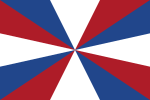 | 1931–present | The "Geus", the naval jack of the Netherlands | Twelve segments in the colours of the kingdom flag; in the ratio 2:3. |
 | ?–present | Naval jack of the Royal Marechaussee | Triangular flag, the mast side of which has the white colour and the tip is nassau blue. The white area is loaded with an orange Dutch lion, the blue area with the logo of the Marechaussee (the grenade with closed flame).[27] |
| 1934-present | Commissioning pennant | A long, very narrow, split ship's vane in the colours of the kingdom flag. |
Historical
National flags
| Flag | Date | Use | Description |
|---|---|---|---|
 |
800-888 | Imperial Oriflamme of Charlemagne | A 3 pointed green field with 8 golden crosses and 6 flowers. |
 |
959–1190 | Flag of the Lower Lotharingia | A red field with a white stripe in the middle |
 |
1024–1528 | Flag of the Prince-Bishopric of Utrecht | A red field with a white cross |
 |
1183–1430 | Flag of the Duchy of Brabant | A golden lion on a black field. |
 |
1384–1482 | Flag of the Burgundian Netherlands | A white flag with the cross of Burgundy, firesteel, and Golden Fleece |
 |
1482–1556 | Flag of Habsburg Netherlands | A white flag with the cross of Burgundy.[28][29] |
| 1556–1648 | Flag of Spanish Netherlands | ||
 |
1556–1648 | Civil ensign of the Spanish Netherlands | A horizontal tricolour of red, white and yellow, with the Cross of Burgundy in the centre. |
 |
1572–1795 | The Prince's Flag | A horizontal tricolour of orange, white and blue. |
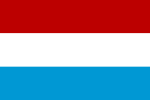 |
1652–1806 | The States Flag | A horizontal tricolour of red, white and blue. The blue is a lighter shade than that of the current national flag |
 |
1796–1806 | The Batavian flag | A horizontal tricolour of red, white and blue with the Republic’s emblem in the canton. |
 |
1806–1810 | Flag of the Kingdom of Holland | A horizontal tricolour of red, white and blue. |
| 1813–1815 | Flag of the Sovereign Principality of the United Netherlands | ||
| 1815–1839 | Flag of the United Kingdom of the Netherlands | ||
| 1839–present | Flag of the Kingdom of the Netherlands |
Colonies and overseas territories
| Flag | Date | Use | Description |
|---|---|---|---|
 |
1637?-1644? | Flag of Dutch Brazil | Horizontal stripes in red, white and blue, with a crown and a gold monogram in the centre |
 | |||
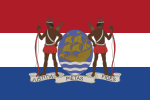 |
1961–1962 | Proposed flag of Dutch Guyana (Suriname) | Horizontal stripes in red, white and blue, with a coat of arms in the centre |
 |
1959–1975 | Flag of Dutch Guyana (Suriname) | A white flag with white, black, brown, red and yellow five-pointed stars, connected by a black ellipse |
 |
1961–1962 | Flag of Netherlands New Guinea | Thirteen blue and white alternating horizontal stripes with a red bar on the hoist side with a white five pointed star centred on it |
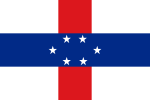 |
1959–1986 | Flag of the Netherlands Antilles | White, with a horizontal blue stripe in the centre, one-third of the flag's hoist, superimposed on a vertical red stripe of the same width, also centred; six white, five-pointed stars are arranged in a hexagon pattern in the centre of the blue band, their points up. The six stars represented the six main islands of Aruba, Bonaire, Curaçao, Saba, Sint Eustatius, and Sint Maarten |
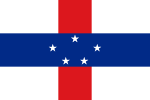 |
1986–2010 | Flag of the Netherlands Antilles after the secession of Aruba | White, with a horizontal blue stripe in the centre, one-third of the flag's hoist, superimposed on a vertical red stripe of the same width, also centred; five white, five-pointed stars are arranged in a pentagon pattern in the centre of the blue band, their points up. The five stars represented the five main islands of Bonaire, Curaçao, Saba, Sint Eustatius, and Sint Maarten. |
Provinces
| Flag | Date | Use | Description |
|---|---|---|---|
 |
1948–1986 | Flag of South Holland | A yellow flag with a red horizontal stripe through the middle |
Royal standards
| Flag | Date | Use | Description |
|---|---|---|---|
 | 1908–2013 | Royal Standard of the Monarch | A square orange flag, divided in four quarters by a nassau-blue cross with the small coat of arms of the Kingdom, surmounted by a royal crown and surrounded by the insignia of the Grand Cross of the Order of William. Each quarter shows a bugle-horn, which originates in arms of the Principality of Orange. |
 | 1815–1908 | Royal Standard of the Monarch | The colours of the flag of the Netherlands with the royal coat of arms (without the mantle). |
Other members of the Royal Family
| Flag | Date | Use | Description |
|---|---|---|---|
 | 1898–1908 | Standard of a Prince | A flag with the colours of the historical Royal Standard, with the Royal coat of arms in an orange rectangle at the central band. |
 | 1898–1908 | Standard of a Princess | A swallow tailed flag with the colours of the historical Royal Standard, with the Royal coat of arms in an orange rectangle at the central band. |
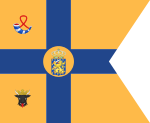 | 1980–2004 | Standard of Juliana of Orange-Nassau | As princess, Juliana used a swallow tailed orange flag, divided in four quarters by a nassau-blue cross. In the centre of the flag is a small arms of the Netherlands without the insignia of the Order of Willem within an orange circle. In the upper hoist her maternal arms (the horn of Orange) and her paternal arms (a black bull with white horns, a red tongue and a golden crown, from the arms of Mecklenburg) in the lower hoist. |
 | 1908–1934 | Standard of Emma of Waldeck-Pyrmont | She used a square and swallow tailed orange flag, divided in four quarters by a nassau-blue cross. In the centre of the flag is a small arms of the Netherlands without the insignia of the Order of Willem within an orange circle. Each quarter shows a bugle-horn, which originates in arms of the principality of Orange. |
 | 1898–1908 | Standard of Emma of Waldeck-Pyrmont | She used a flag with the colours of the historical Royal Standard, with the Royal coat of arms (without the mantle) at the central band. |
 | 1908–1910 | Standard of Marie of Orange-Nassau | An oblong flag of orange colour, the height of which is 5/6 of the length, triangularly cut over 1/3 of the length of the flag; divided into four sections by a standing four-armed cross of Nassau blue, the width of 1/5 of the height of the flag; the centre of the cross located at 5/12 of the length of the flag, counted from the pants side; in the centre of the cross a medallion of orange colour, at the diameter of 3/14 of the length of the flag, placed below it the coat of arms, as mentioned in article 1 of this decree, covered by the royal crown; in each of the orange boxes, located on the trouser side of the flag, a horn, as defined in Article 1. |
 | 1980–2002 | Standard of the Prince Consort | A quadrangle in Nassau blue bearing an orange cross. First and third quarters, adorned by the Dutch Lion of the coat of arms of The Netherlands. Second and fourth quarters, adorned by the white castle tower from the coat of arms of the House of Amsberg. Centred upon the cross is the coat of arms of The Netherlands, topped by a royal crown. |
 | 1948–1980 | Standard of the Prince Consort | A quadrangle bearing an orange cross. First and third quarters in Nassau blue, adorned by the Dutch Lion from the national coat of arms. Second and fourth quarters are white, adorned by the five-leafed rose with golden sepals from the coat of arms of the House of Lippe. Centred upon the cross is the coat of arms of The Netherlands, topped by a royal crown. |
 | 1908–1934 | Standard of the Prince Consort | A quadrangle bearing an orange cross. First and third quarters in Nassau blue, adorned by the Dutch Lion from the national coat of arms. The second and fourth quarters are Azure, adorned by a griffin passant Or langed Gules of the House of Mecklenburg. Centred upon the cross is the coat of arms of The Netherlands, topped by a royal crown. |
 | 1902–1908 | Standard of the Prince Consort | A flag with the colours of the historical Royal Standard, with the prince's coat of arms at the central band. |
Dutch governors
| Flag | Date | Use | Description |
|---|---|---|---|
 |
1904–1920 | Flag of the governor of Curaçao and Dependencies | National tricolour, within the red stripe two white balls. |
| 1816–1920 | Flag of the governor of Surinam | ||
| 1880–1928 | Flag of the governor of the Dutch East Indies | ||
 |
1928–1949 | Flag of the governor of the Dutch East Indies | National tricolour, within the upper-right white canton, two red balls. |
 |
1920–1966 | Flag of the governor of Curaçao and Dependencies | National tricolour, within the red stripe three white balls. |
| Flag of the governor of Surinam | |||
| 1951–1962 | Flag of the governor of Dutch New Guinea | ||
 | 1966–1975 | Flag of the governor of Suriname | A white flag with the flag of the Netherlands striped across both the top and the bottom, and the flag of Suriname in the centre. |
 | 1966–1986 | Flag of the governor of the Netherlands Antilles | A white flag with the flag of the Netherlands striped across both the top and the bottom, and the flag of the Netherlands Antilles in the centre. |
 | 1986–2010 | Flag of the governor of the Netherlands Antilles | A white flag with the flag of the Netherlands striped across both the top and the bottom, and the flag of the Netherlands Antilles in the centre. |
Military and naval flags
| Flag | Date | Use | Description |
|---|---|---|---|
 | 1957-2023 | Flag of the Minister of Defence | Seven horizontal bands in the colour combination red-white-blue-white-red-white-blue in the ratio 1:1:1:6:1:1:1 with the emblem of the armed forces in the middle. |
 | 1974-2005 | Flag of the Chef Defensiestaf | Seven equally high horizontal bands in the colour combination red-white-blue-white-red-white-blue. In the middle a green circle with four swords representing the four armed forces. |
 | 2001-2010 | Governmental flag of the Ministry of Defence | Dark purple flag with 4 orange bands on the hoist side; the right lane is not complete. |
 | 2001-2010 | Governmental flag of the Royal Netherlands Navy | Dark blue flag with 4 orange bands on the hoist side; the right lane is not complete. On the other side is the logo of the Royal Netherlands Navy. |
 | 2001-2010 | Governmental flag of the Royal Netherlands Army | Dark green flag with 4 orange bands on the hoist side; the right lane is not complete. On the other side is the logo of the Royal Netherlands Army. |
 | 2001-2010 | Governmental flag of the Royal Netherlands Air Force | Dark blue flag with 4 orange bands on the hoist side; the right lane is not complete. On the other side is the logo of the Royal Netherlands Air Force. |
 | 2001-2010 | Governmental flag of the Royal Marechaussee | Dark blue flag with 4 orange bands on the hoist side; the right lane is not complete. On the other side is the logo of the Royal Marechaussee. |
 | ?–? | Pilot flag | A flag of three equally wide bands of red, white and blue with a ratio of 3:2, bordered on all sides in white with a width equal to the width of the band. |
House flags
| Flag | Date | Company | Description |
|---|---|---|---|
Current flags | |||
 | ?–present | Boskalis | Flag divided diagonally into two halves, yellow on the top and navy blue on the bottom. This part contains the company name in blank. |
 | 1921–present | Spliethoffnl | Flag divided diagonally into four parts, with the upper part being orange, the flight sky blue, the lower part white and the mast red. In the centre loads the initial of the company name in black.[30] |
 | 1898–present | Wagenborgnl | Flag divided diagonally into four parts, the top and bottom being red, and the other two white. In the centre is a black chimney with two white stripes.[31] |
Former flags | |||
 | 1993-2018 | Dockwise | White field with the company's emblem in the centre. |
 | 1970-1997 | Nedlloyd | White and blue quartered flag; a gourd cross, formed by two intertwined ropes, and fimbriated in white. |
 | 1907-1965 | Batavian Oil Companynl | Two equal red triangles at the top and two equal blue triangles at the bottom, with a white diamond with the royal crown in the middle. |
 | 1888-1966 | Royal Packet Navigation Company | Bright red field flag with a white horizontal lozenge, over the full length and height of the flag, charged with the royal crown. |
 | 1885-1974 | Holland Steamship Company | White field with the national flag of the Netherlands in the quarter and the initials "HSM" in red on the fly. |
 | 1883-1970 | Royal Rotterdam Lloyd | A red, rectangular flag with a white cross. In the centre is a blue square with the white letters 'RL' and a crown above it. |
 | 1870-1970 | Netherland Line | White field with a blue sautor on which is placed a small red rhombus containing the letter N in white |
 | 1856-1981 | Royal Netherlands Steamship Company | Blue field flag with a white horizontal lozenge, over the full length and height of the flag, charged with the royal crown. |
 | 1621-1792 | Dutch West India Company | National flag with company initials, GWC, in black on white central stripe. |
 | 1630s-1799 | Dutch East India Company | National flag with the company's initials, VOC, in black on the white central stripe. |
 | 1602-1630s | Prince's Flag with company initials, VOC, in black on white central stripe | |
See also
References
External links
Wikiwand in your browser!
Seamless Wikipedia browsing. On steroids.
Every time you click a link to Wikipedia, Wiktionary or Wikiquote in your browser's search results, it will show the modern Wikiwand interface.
Wikiwand extension is a five stars, simple, with minimum permission required to keep your browsing private, safe and transparent.